Athanasia trifurcata
Athanasia trifurcata (L.) L.
Family: Asteraceae
Common names: trifid-leaf athanasia, coulter bush, klaas louw bush, three-tooth athanasia (Eng.), kouterbos, klaaslouwbos (Afr.)
Introduction
A fast-growing shrub with grey 3-forked leaves, displaying showy clusters of beautiful yellow flower heads in early summer, well suited for fynbos, renosterveld, karoo and coastal gardens.
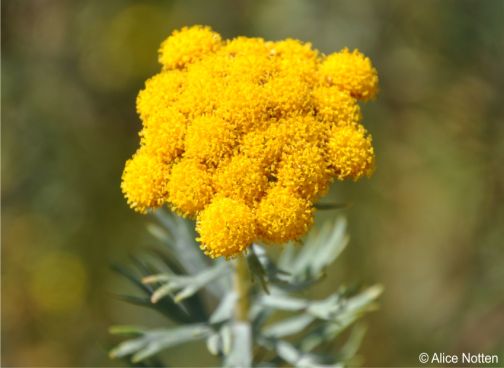
Description
Description
Athanasia trifurcata is an evergreen, aromatic shrub, with a growing height of up to 1.5 m. Most often, the coulter bush grows with a very short, single stem that can barely be seen from a distance, which produces multiple branches from the base. These branches form a beautiful rounded shape, in ideal growth conditions. The stem and branches are fairly smooth, brown in colour and covered with silver to greyish bark. The leaves of A. trifurcata are narrow, up to 40 mm long, greyish green to bright green and do not have a stalk but are attached directly and singly on the stem, the leaf blade tapering into the stem. The leaves split into 3 teeth (occasionally 5) at the tips, are rough on the surface and covered with a fine greyish powder.

The bright yellow inflorescence is a flat-topped cluster of flower heads at the tip of the erect branches, in early summer (October to November). Each flower head contains, on average, between 50–100 small cylindrical flowers, and each inflorescence is made up of about 20–30 flower heads clustered together. Confusion can occur between A. trifurcata and A. crithmifolia, this is because both species flower in October and November and they share some close similarities as well. However, A. crithmifolia grows bit taller than its relative, up to 2 m in height, and it has longer and more linear leaves when compared to the wedge-shaped leaves of A. trifurcata. Coulter bush produces small seeds after flowering that can be collected in late summer, between January and February.
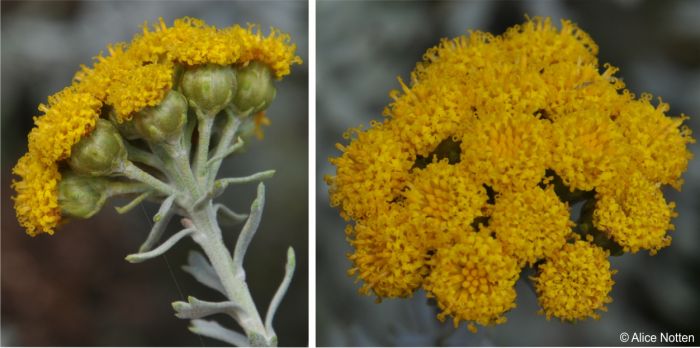
Conservation Status
Status
This species is not considered to be threatened in its habitat early in the twenty first century, consequently it is listed as Least Concern (LC) in the Red List of South African plants.
Distribution and habitat
Distribution description
The coulter bush is native to South Africa where it grows mainly in the winter rainfall region, widely distributed from Namaqualand in the Northern Cape, through the Western Cape and the Little Karoo to Port Elizabeth, in the Eastern Cape. This species grows in dry habitats, on flats and rocky slopes. It grows in full sun and warm climates and can tolerate light frost. This waterwise bush grows very well in well-drained sandy soil. It is drought tolerant and can survive with limited water supply. Coulter bush can be found growing on disturbed lands as one of the pioneer species, especially in Namaqualand and the Renosterveld vegetation.
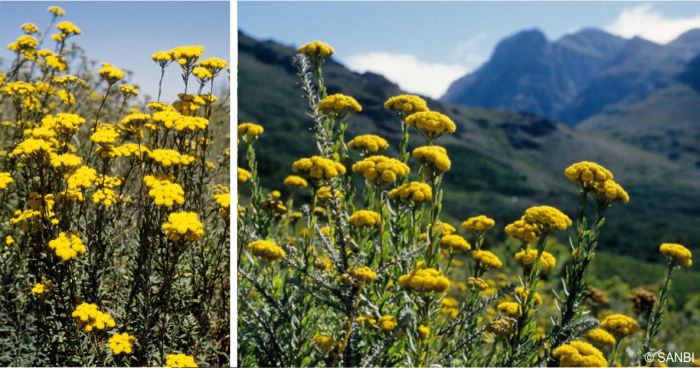
Derivation of name and historical aspects
History
The name Athanasia means ‘without death’ and it comes from the Greek word thanatos, and refers to the bracts at the bottom of the inflorescence that remain on the inflorescence even when it is dry. The specific epithet trifurcata means ‘three-forked’, as can be seen on the leaves of A. trifurcata, which split into three at the tip. Such three-forked plant parts are normally called tris or tres in Latin.
The plant’s common name, kouterbos in Afrikaans, meaning coulter bush, originates from the problems farmers faced when the plant’s branches gathered on the coulter of their plough, forcing them to halt and clear the debris. The coulter (also spelled colter), which is fastened to a plough’s beam and functions as a cutting tool for the ground in front of the ploughshare, is a sharp blade or wheel-like disk. The common name klaaslouwbos or Klaas Louw bush, derives from the story that it was a certain farmer called Klaas Louw that allowed A. trifurcata to spread and become weedy on his lands, which eventually became a problem to his neighbouring farmers.
Coulter bush is considered one of the important taxa in the coastal Renosterveld, in terms of plant species that are contributing to the vegetation classification. This species belongs to the large daisy family, called Asteraceae. Athanasia is a genus of 39 species that can be found in the Eastern Cape, Northern Cape and Western cape, 1 of the species can be found growing in KwaZulu- Natal and 1 species in Namibia. A large number of the species occur in the fynbos biome, in the winter-rainfall region. The whole Athanasia genus is endemic to southern Africa, with most species found in South Africa.
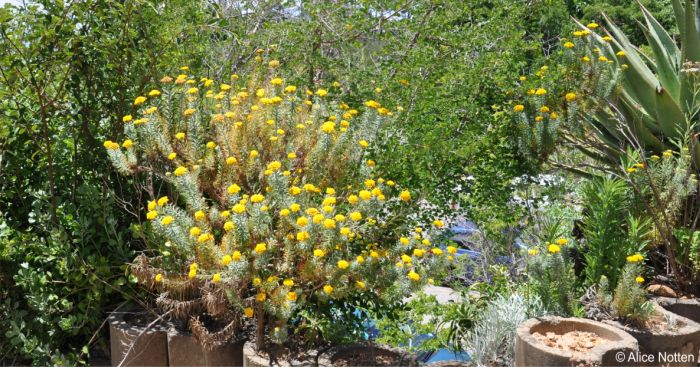
Ecology
Ecology
The coulter bushes are pollinated by different flying insects, which includes bees, beetles, wasps, thrips and butterflies. This species is not a resprouter but propagates itself well with seedlings when affected by fires. It may take a year or two for A. trifurcata to reach flowering stage and start producing seeds. The coulter bush is most likely not palatable and there is a report of some sheep dying and others becoming photosensitive after grazing in a paddock heavily infested with A. trifurcata.
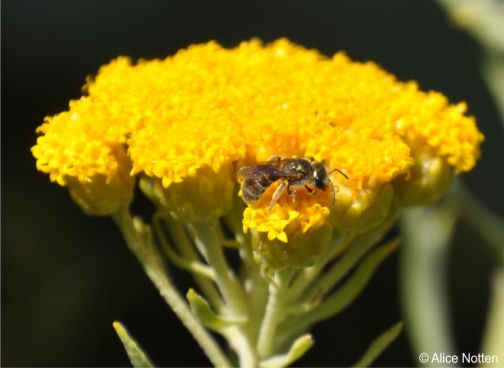
Uses
Use
Athanasia trifurcata can be used in gardens as an ornamental plant as well as a waterwise plant in xeriscaped gardens. Pollinating insects are attracted to the small yellow flowers which occur in mid-spring to early summer, hence favouring this species as an excellent host to feed a variety of flying insects. Coulter bush also provides a landscape with texture and colour and its grey-green foliage can be used as a filler between green foliage plants in the garden.
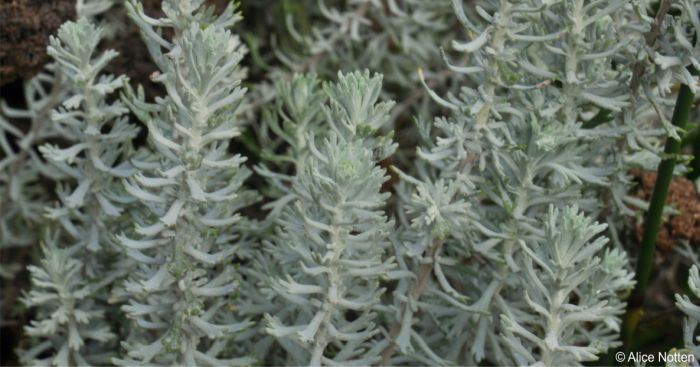
Growing Athanasia trifurcata
Grow
The coulter bush is a flowering shrub that is easy to grow and adaptable. It tolerates light frost and can be grown in dry, warm climates. This flowering shrub prefers to grow in spaces exposed to full sun with temperature ranging from 20 to 35°C. The best growth medium for coulter bush is sandy soil that is well-draining and slightly acidic. This species is drought-tolerant and plants can be watered when the soil is almost completely dry however they will perform better with regular watering.
Athanasia trifurcata can easily be reproduced in autumn through seed sowing, or by cuttings. The coulter bush seeds germinate faster with the use of smoke treatment, it is usual with most species that are native to the Fynbos Biome – most specifically those that are found growing in the fynbos vegetation types. In most times, the usual smoke treatment applied includes keeping seeds inside the enclosed tunnel and channel the fire smoke to the tunnel for at least 2 hours, then sow seeds afterwards. Another possible method that can be applied is to smoke seeds by soaking or watering seeds with smoke water. It is always a best practice to derive smoke from fynbos plant material to treat seeds. Coulter bush does not require special treatments to be grown, a general seed sowing mix or fynbos germination mix can be used to sow seeds of this species. Sown seed trays can be placed under light shade and kept moist until they germinate. Germination can take on average between 6–12 weeks. For better germination outcomes, seed trays should not be left to dry out.
Propagations by cuttings can be an alternative method to reproduce Athanasia trifurcata. However, with this species reproducing very well in the wild through seeding, cuttings are not usually done in National Botanical Gardens. Ideally, fresh semi-hardwood cuttings should be collected in autumn from a healthy mother plant and used for propagation. A soil mixture with high sand content that supports good drainage would be suitable to propagate coulter bush by cuttings. Cuttings can be placed and monitored under a light shade shelter, watered with a mist sprayer to avoid soil retaining high moisture.
This species grows well without the use of fertilisers or any other soil supplements. However, where necessary, plants can be fertilised using a balanced organic fertilizer applied early in the growing season. Coulter bush grows well as a dense flowering shrub in the garden with its appealing grey-green leaves and yellow flowers. Dead flowers and branch tips should be pruned prior to the flowering season to give the plant a denser appearance and producing more flowers. This species is not prone to pests and diseases, thus it shows a high resistance to such factors.
References
- Botha, C.J., Venter, E. 2002. Athanasia trifurcata. University of Pretoria. Faculty of Veterinary Science. Dept. of Paraclinical Sciences. Section Pharmacology and Toxicology. https://repository.up.ac.za/handle/2263/8534. Accessed 21/11/2023.
- Consulta Plantas. Gardening and plant care since 2001. Athanasia trifurcata. https://www.consultaplantas.com/index.php/en/care-plants-from-a-to-c/1719-athanasia-trifurcata-or-samphire-leaf-athanasia-care-and-growing. Accessed 20/11/2023.
- Fynbos Life Fair . 2020. Athanasia trifurcata, Asteraceae. https://www.fynboslife.com/plantprofile/athanasia-trifurcata/. Accessed 22/11/2023.
- Kellerman, T.S. & Coetzer, A.W. 1985. Hepatogenous photosensitivity diseases in South Africa. Onderstepoort Journal of Veterinary Research 52:157–173.
- Latti, I. n.d. Athanasia trifurcata leaves. https://www.operationwildflower.org.za/index.php/albums/genera-a/athanasia/athanasia-trifurcata-klaas-louwbos-il-1-6647. Accessed 22/11/2023.
- Leaf Library.. Athanasia trifurcata. https://leaflibrary.com/athanasia-trifurcata/. Accessed 22/11/2023.
- Manning, J. & Goldblatt, P. 2012. Plants of the Greater Cape Floristic Region 1: the Core Cape Flora. Strelitzia 29. South African National Biodiversity Institute, Pretoria.
- Notten, A.L. 2018. Athanasia crithmifolia (L.) L. (Asteraceae). PlantZAfrica. Online. http://pza.sanbi.org/athanasia-crithmifolia.
- Raimondo, D., Von Staden, L., Foden, W., Victor, J.E., Helme, N.A., Turner, R.C., Kamundi, D.A. & Manyama, P.A. (eds) 2009. Red list of South African plants. Strelitzia 25. South African National Biodiversity Institute, Pretoria.
Credits
Maria van der Westhuizen and Thabang Makola
Karoo Desert National Botanical Garden
March 2024
Acknowledgements: images by Alice Notten
Plant Attributes:
Plant Type: Shrub
SA Distribution: Eastern Cape, Northern Cape, Western Cape
Soil type: Sandy, Clay, Loam
Flowering season: Spring, Early Summer
PH: Acid, Neutral
Flower colour: Yellow
Aspect: Full Sun
Gardening skill: Easy
Special Features:
Horticultural zones










Rate this article
Article well written and informative
Rate this plant
Is this an interesting plant?
Login to add your Comment
Back to topNot registered yet? Click here to register.